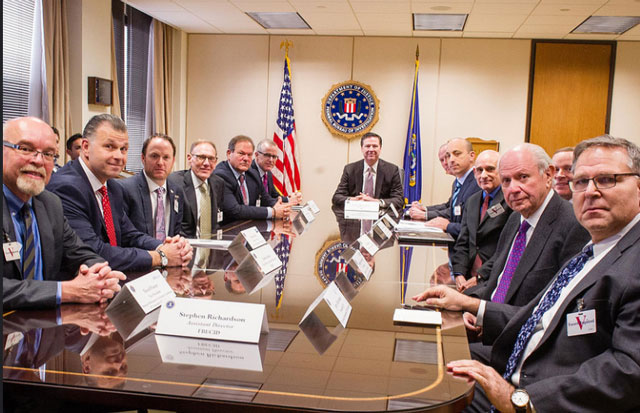
Democrats — already angry that Congressional inquiries into Russian meddling have been hamstrung by Republicans’ willingness to defend Trump — voiced sharp concerns that the FBI’s investigation may now be in jeopardy too, with several calling for an independent commission to take over the probe.
“This is nothing less than Nixonian,” charged Senator Patrick Leahy of Vermont, who called Trump’s official justification for firing Comey “absurd.”
“That fig leaf explanation seeks to cover the undeniable truth: The president has removed the sitting FBI director in the midst of one of the most critical national security investigations in the history of our country — one that implicates senior officials in the Trump campaign and administration,” he charged.
When Trump initially decided to keep Comey — a Barack Obama appointee — in his job, it raised eyebrows from critics who saw it as a tacit reward for his role in damaging Clinton’s chances.
But within months, the FBI chief was back in the national spotlight — this time taking aim at Trump.
During testimony to Congress last month, Comey overtly challenged the president, flatly rejecting his explosive claim that he was wiretapped by his predecessor.
And despite Trump’s dismissal of suggestions his team colluded with Moscow as “fake news,” it had become increasingly clear that Comey had set his sights on the issue of Russia’s election meddling, which has stalked Trump’s presidency from the start.
Key dates in the Trump-Comey relationship
Donald Trump and FBI director James Comey, who was fired by the president on Tuesday, have been on a collision course since last year when US intelligence discovered a Russian plot to interfere in the presidential election.
Here are key dates in the saga:
— July 2016: The FBI quietly opens an investigation into Russian interference in the US election, which would only be officially revealed eight months later
— October 7, 2016: US intelligence officials announce that top Russian officials are behind hacking and disinformation operations designed to disrupt the election
— November 8, 2016: Trump wins the election in a shock upset over Democrat Hillary Clinton, under the shadow of Russian interference and Comey’s controversial handling of an investigation into Clinton’s private email server
— December 10, 2016: Democrats accuse Comey of withholding information about Russian election interference during the campaign to boost Trump
— January 6, 2017: Comey and three other top intelligence officials brief Trump on their conclusion that Russian President Vladimir Putin was behind the bid to interfere with the election, in support of Trump
— Mid-January 2017: Trump asks Comey to stay in his post in the new administration
— February 14, 2017: The FBI rejects a White House request to refute a New York Times story alleging numerous contacts between Trump campaign officials and Russian intelligence
— February 24, 2017: Trump blasts the FBI over news reports on the Russia case, tweeting: “The FBI is totally unable to stop the national security ‘leakers’ that have permeated our government for a long time”
— March 8, 2017: Comey says he plans to stay in his job for a full 10-year term, until 2023, quipping: “You are stuck with me for another six-and-a-half years”
— March 20, 2017: Comey confirms for the first time that the FBI is investigating Russian interference in the election — including any links between individuals associated with the Trump campaign and the Russian government, and any possible coordination between the campaign and Russia’s efforts.
He also flatly denies Trump’s claim that former president Barack Obama ordered investigators to tap the phones at Trump’s New York home.
— May 9, 2017: Trump fires Comey
 The Independent Uganda: You get the Truth we Pay the Price
The Independent Uganda: You get the Truth we Pay the Price



